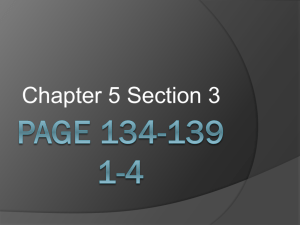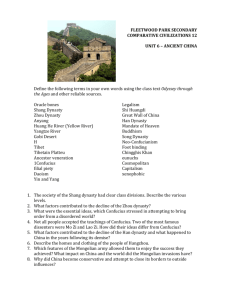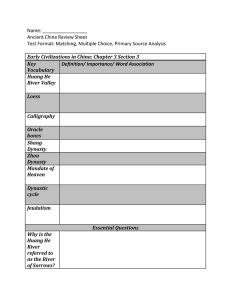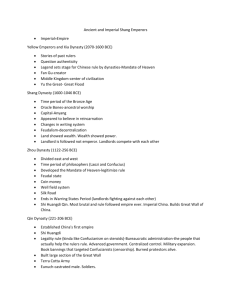Ms. Beard's Notes World Civilizations: The Global Experience 6th
advertisement
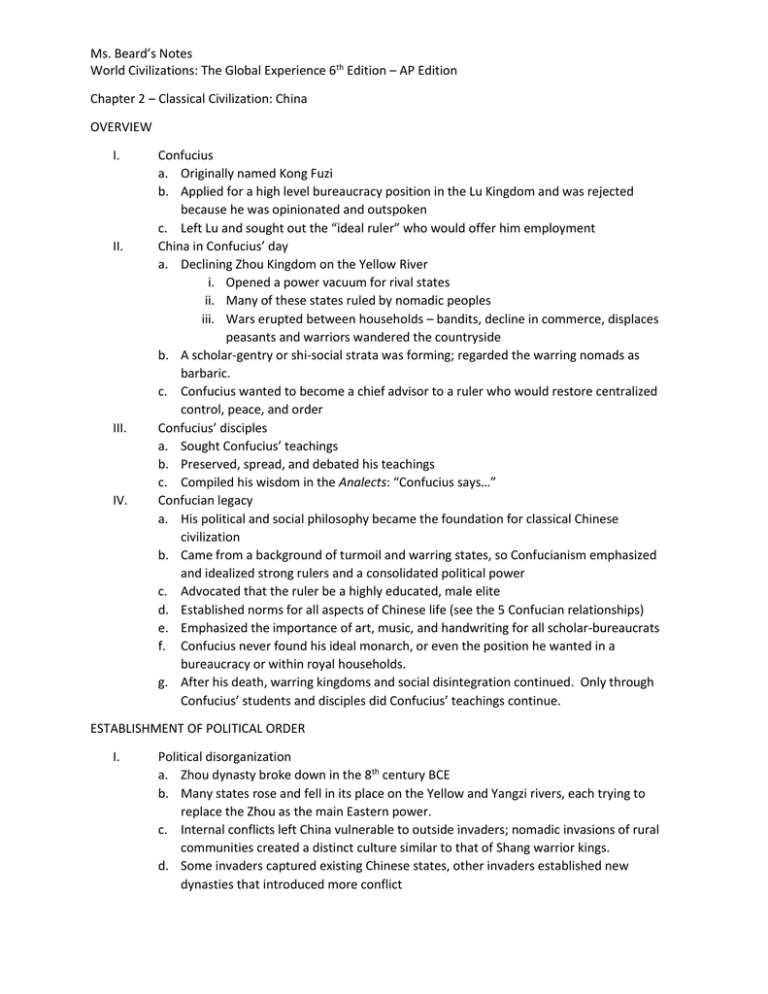
Ms. Beard’s Notes World Civilizations: The Global Experience 6th Edition – AP Edition Chapter 2 – Classical Civilization: China OVERVIEW I. II. III. IV. Confucius a. Originally named Kong Fuzi b. Applied for a high level bureaucracy position in the Lu Kingdom and was rejected because he was opinionated and outspoken c. Left Lu and sought out the “ideal ruler” who would offer him employment China in Confucius’ day a. Declining Zhou Kingdom on the Yellow River i. Opened a power vacuum for rival states ii. Many of these states ruled by nomadic peoples iii. Wars erupted between households – bandits, decline in commerce, displaces peasants and warriors wandered the countryside b. A scholar-gentry or shi-social strata was forming; regarded the warring nomads as barbaric. c. Confucius wanted to become a chief advisor to a ruler who would restore centralized control, peace, and order Confucius’ disciples a. Sought Confucius’ teachings b. Preserved, spread, and debated his teachings c. Compiled his wisdom in the Analects: “Confucius says…” Confucian legacy a. His political and social philosophy became the foundation for classical Chinese civilization b. Came from a background of turmoil and warring states, so Confucianism emphasized and idealized strong rulers and a consolidated political power c. Advocated that the ruler be a highly educated, male elite d. Established norms for all aspects of Chinese life (see the 5 Confucian relationships) e. Emphasized the importance of art, music, and handwriting for all scholar-bureaucrats f. Confucius never found his ideal monarch, or even the position he wanted in a bureaucracy or within royal households. g. After his death, warring kingdoms and social disintegration continued. Only through Confucius’ students and disciples did Confucius’ teachings continue. ESTABLISHMENT OF POLITICAL ORDER I. Political disorganization a. Zhou dynasty broke down in the 8th century BCE b. Many states rose and fell in its place on the Yellow and Yangzi rivers, each trying to replace the Zhou as the main Eastern power. c. Internal conflicts left China vulnerable to outside invaders; nomadic invasions of rural communities created a distinct culture similar to that of Shang warrior kings. d. Some invaders captured existing Chinese states, other invaders established new dynasties that introduced more conflict II. III. Unity a. Qin dynasty’s attempt i. In 221 BCE Shi Huangdi’s Qin (a warrior leader) dynasty defeated all other rivals; a new imperial dynasty was formed. ii. Shi Huangdi turned out to be a tyrant iii. Shi Huangdi died in 210 BCE, and revolts began to spread across the Qin empire. iv. Qin dynasty ended in 207 BCE and gave rise to the Han dynasty. b. Han dynasty’s attempt i. Lasted more than 400 years; consolidation of Chinese civilization ii. Unity achieved, and political control was extended throughout the empire. iii. Han leaders developed the an effective and long lasting bureaucracy iv. The identity that came with the Han empire’s successful bureaucracy helped preserve Chinese culture through centuries of war, invasions, and internal division after the Han empire collapsed in the 3rd century CE Cultural Traditions a. Being isolated meant that it had limited interaction with other cultures, but less chance of invasion from outsiders. This led to a distinct Chinese culture, only remotely influenced by the other early civilizations. b. Harmony of nature i. Every feature is balanced by an opposite, every yin has a yang 1. For hot there is cold 2. For man there is woman ii. An individual should seek a way to relate to the harmony, avoiding excess and appreciating the balance of opposites c. Balance, Dao, and yin/yang were intrinsic to diverse philosophies and religions established in classical China d. Many changes in religion and politics, and continuity in culture PATTERNS IN CLASSICAL CHINA I. Vocab a. Zhou Dynasty – Originally a vassal family from Shang China who overthrew the Shang and established a dynasty that flourished from 1122-256 BCE b. Qin Dynasty – Established in 221 BCE at the end of the warring states period that followed the end of the Zhou dynasty. The Qin dynasty ended in 207 BCE; the founder, Shi Huangdi, died in 210 BCE and his empire quickly fell to internal conflict and peasant revolts. c. Han Dynasty – Established in 202 BCE after the fall of the Qin empire. It unified China, created an effective bureaucracy, maintaining Chinese culture for future generations. The Han dynasty fell in the early 3rd century CE. d. Confucius – Also known as Kung Fuzi; major Chinese philosopher born in 6th century BCE; author of Analects; philosophy based on need for restoration of order through advice of superior men. e. Great Wall – Chinese defensive fortification intended to keep out the nomadic invaders from the north; initiated during the Qin dynasty f. II. III. Legalism – a pragmatic view that rejected Confucianism and favored an authoritative state that ruled by force. The army controls the people, and the people labor. People required restraint and discipline. Pleasures and courtesy was dismissed as unnecessary and frivolous. g. Daoism – A more religious philosophy which arose roughly at the same time as Confucianism. It embraced spiritual beliefs in nature’s harmony, and that nature contains a divine impulse that directs all life. Daoist harmony with nature was best obtained by humility and frugal living (no extravagance). Political activity and learning were unnecessary to have a good life, and world conditions were not important. Zhou Dynasty (decentralized politics but cultural innovations) a. Location i. 1029-258 BCE ii. Yellow River in Northeastern China b. Society i. Mandate of Heaven- justification for Chinese imperial rule ii. Emperors lived in a world of pomp and ceremony c. Politics i. Political structure flourished until 700 BCE, when frequent invasions by nomadic peoples and a decline in political infrastructure occurred. ii. No powerful government- ruled through alliances with regional princes and noble families iii. Rulers gave large regional states to family and supporters in return for loyalty, tax revenue, and troops (feudal structure) iv. Decline came when regional land-owning families solidified their power and disregarded the central government v. Encouraged settlement in the Yellow River valley vi. Territorial expansion made central rule difficult (hard to communicate and transport goods from the capital to the outlying regions) d. Interaction i. Plagued by invading nomadic peoples ii. Trading between central city and outlying regions e. Culture i. Banned human sacrifice and urged restrained ceremonial worship ii. Linguistic unity -> beginnings of Mandarin Chinese iii. Oral epics and stories in Chinese aided in the development of a common cultural currency iv. Philosophical ideas to help define Chinese culture amid political crises and disunity v. Chopstick use began at the end of the Zhou dynasty! f. Economy i. Rich agricultural lands- wheat in the north, rice in the south. Qin Dynasty (Emphasized order and centralization) a. Location i. Eastern China IV. ii. 221 BCE – 207 BCE b. Society i. Aristocrats’ lands were taken away in order to prevent any insurrection of Shi Huangdi’s power ii. Peasant class existed as the labor force, but they were chosen to work by the bureaucracy instead of the feudal system they were in during the Zhou dynasty c. Politics i. Shi Huangdi – a brutal ruler but effective in unifying the internal disorder 1. Ordered nobles to leave their regions, assuming control of the feudal estates 2. Selected non-aristocratic rulers to run large provinces; this assures loyalty to the emperor ii. Extended Chinese territory while maintaining a centralized government iii. Peasant revolts on Shi Huangdi’s death in 210 brought about the end of the Qin dynasty- one family defeated the rest and established the Han dynasty d. Interactions e. Culture i. Great Wall of China – built by forced labor, chosen by the bureaucracy from among the peasants. ii. National census – data for the calculation of tax revenues and labor service iii. Standardized coinage, weights, and measures throughout China iv. Uniform Chinese script to make communication possible throughout all China v. Burned books – thinking is subversive to autocratic rule f. Economy i. Agricultural advancements- irrigation, manufacturing ii. Silk cloth manufacturing Han Dynasty a. Location i. 202 BCE – 220 CE ii. Most of eastern China and parts of Northern Central China b. Society i. Most famous Han ruler, Wu Ti, enforced peace throughout Han China ii. Confucian philosophy was the official statement of Chinese values c. Politics i. Retained the centralized administration of the Qin dynasty ii. State bureaucracy improved- government training linked to Confucian philosophy (scholar-bureaucrats) 1. Civil Service tests that covered Chinese literature 2. Schools built to train men for the bureaucracy and civil service tests iii. By the end of the Han dynasty, there were about 130,000 bureaucrats d. Interactions i. Trade and contact with India, Parthian Empire, Roman Empire. ii. Invasions from central Asia by the Huns overturned the Han empire e. Culture f. i. Confucian shrines put up around China to honor and worship him Economy i. Iron and salt production ii. Public works projects in irrigation and canal systems iii. Regulation of agricultural supplies (wheat and rice) in good times to control price increases and unrest/revolts when harvests were bad


